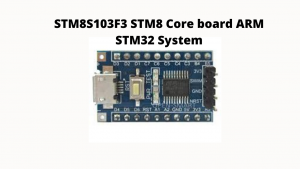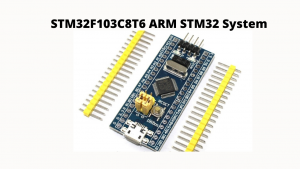STM8S103F3 STM32F103C8T6 software developer
Who is a stm8s103f3 stm32f103c8t6 software developer?
stm8s103f3 stm32f103c8t6 software developer is a engineer who works on stm based chipsets 8 bit or 32 bit. He mainly works on low level driver development using C and freeRTOS.
Are you looking for a stm8s103f3 stm32f103c8t6 software developer then get in touch. We can help you find the right skills for your requirements.
This STM8S103F3 STM8 function generator is an experimental low-cost device board for the STM8S103F3P6 Microcontroller. On default 2.54 mm pitch headers, all of the MCU pins are supplied on board. It has an onboard voltage regulator and uses a micro USB connector to provide USB power. This panel is perfect for any STM8S103F3P6-based prototype programme. You can distinguish your designs using this panel by attaching several additional peripheral devices. Appropriate for those who would like to understand the microcontroller STM8S
Interface with optimized SWIM and can be configured with ST-LINK V22
- LED Reset Button and Control Indicators on Board
- In order to monitor it, the on-board LED test predictor and newcomers can programme
- The on-board 3.3V 3.3mA regulator
- All GPIOs are removed and the names of pins are labelled
- You can direct attach the board to the board after soldering the header,
8 Kbyte Flash programme memory, plus integrated true EEPROM data, is provided by the STM8S103F2 / x3 access line 8-bit microcontrollers. The reference manual of the STM8S microcontroller family (RM0016) refers to devices in this family as low-density. They have the following advantages: efficiency, robustness and lower cost of the device. The efficiency and robustness of the unit are assured by advanced core and peripheral devices built with government state-of-the-art technology, a 16 MHz clock rate, robust I / OS, independent clock reference autonomous watch dogs, and a clock protection system. Due to an optimised actual knowledge EEPROM for up to 300 k write / erase cycles and a high degree of device integration with clock signal waveforms, watchdog and grey-out reset, the system rate is lower. Along with a broad choice of development tools, established processes are provided.

Figure. 1
How stm8s103f3 stm32f103c8t6 software developer works?
When Arduino began with circuitry, it would’ve been the first platform for several enthusiasts and engineers out there. Even so, as we begin to create more often and start digging, we will quickly realize that Arduino is not ready for enterprise and that its 8-bit CPU with a painfully slow clock does not give you sufficient energy for your ventures. God willing, however, now have the latest STM32F103C8T6 STM32 Development Boards (Blue Pill) on the market that, with its 32-bit Processor and ARM Cortex M3 architecture, can comfortably surpass Arduino. The sock puppet here is where we can programme our STM32 Boards that use the same old Arduino IDE. So, let’s get started with the STM32 in this tutorial to learn a bit of fundamentals about this device and blinking the on-board LED using the Arduino IDE. The a.k.a Blue Pill STM32 board is an ARM Cortex M3 Microcontroller development system. It looks a lot like the Arduino Nano, but it produces a very punch. The Board for Production is shown below. Especially in comparison with the official Arduino boards, such boards are relatively inexpensive and the hardware is free software as well. The STM32F103C8T6 from STMicroelectronics is the microcontroller on top of it. Because the MCU operates at 3.3V, the board also has a power supply IC of 5V to 3.3V to control the MCU. Most of the GPIO pins are 5V tolerant, although the MCU works at 3.3V. The MCU pins are carefully taken out and marked as pins for the headers.

Figure. 2
Issues with STM32 Blue Pill Board
If you are looking to purchase the cheaper version (which many of us possibly will), there are some documented problems that you need to be informed of with the panels. The 3.3V regulator is the first primary issue. While some boards also use TI’s genuine LM1117 3.3V regulations, almost all of the inexpensive production cabinets are found via an unknown producer’s thin, knock-off regulators. There is no heat security for these regulations and they are easily affected. The answer would be to use, if you’ve the choice, an external controlled power supply. Next two problems are connected to the USB. Second, the micro-USB port’s tig welding efficiency is very low, and if you disconnect and thread the cables into this port regularly, and there is a high risk that the micro-USB connector will come off the surface. To protect the connection, you can use hot glue.
The other problem with USB is the use of an incorrect pull-up resistor. The USB D+ (named USBDP) should be pulled up to 3.3V using a 1.5 K resistor, as per the reference guide of the MCU. But all of these use a 10 K capacitor, as per the blueprints of many Blue Pill panels. If you are planning to work on the transfer of USB data, then you may not get precise results. When you’re in urgent need of a fix, a 1.8 K resistor can be soldered in parallel with the new 10 K resistor. Link the 1.8 K resistor between the A12 and 3.3V pin pins for this. Other known problems are very difficult to hit the reset button, analogue power is linked to electricity output, no USB safety from Schottky Diode, etc.
STM32F103C8T6 software developer tools
Standard Integrated Development Environments (IDEs) including C / C++ compilers and debugging tools from large third-party vendors (free options of up to 64 Kbytes of code are accessible) as well as the embedded software dependencies needed to set up and initialise the MCU or MPU and track its behaviour during initialization.
STM32CubeMX is a graphical application used for any STM32 system setup. The C-code configuration for Cortex-M cores is generated by this simple-to-use graphical interface and creates the Linux System Tree for Cortex-A core. STM32CubeIDE is an environment for Integrated Growth. This IDE contains compilation monitoring functionality and enhanced debug functionality, based on open-source implementations such as Eclipse or the GNU C / C++ toolchain. It also incorporates additional features found in other ecosystem resources, such as the initialization of HW and SW and the creation of code through STM32CubeMX. The STM32CubeMonitor data visualisation tools allow STM32 apps to be monitored and diagnosed at runtime. The latest STM32CubeMonitor tool helps visualise the application behaviour on host devices in different form factors, such as PCs, laptops, or smartphones, with mobile data processing and gets back for multi-format screens. The STM32CubeProgrammer offers an easy-to-use and productive environment via the both debug interface (JTAG and SWD) and the boot loader framework (UART and USB) for reading, writing and verifying system memory. STM32Cube improved tools simplify the setup of MPU and MCU projects and the configuration of on-chip assets. They encourage the growth of projects focused on micro controllers and microprocessors.
Read more about this.